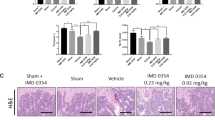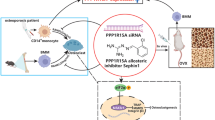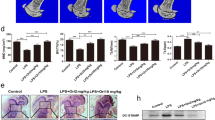Abstract
The transcription factor, nuclear factor-kappa B (NFκB), is believed to play a pivotal role in osteoclast formation. In this study, we focused on NFκB decoy oligodeoxynucleotides (ODN) as a new therapeutic strategy to attenuate osteoporosis. Tartrate-resistant acid phosphatase (TRAP)-positive multinuclear osteoclasts formed in mononuclear cells including osteoclast precursors from neonatal rabbit bone marrow were increased in the presence of 1,25-dihydroxyvitamin D3, whereas transfection of NFκB decoy ODN decreased the number of TRAP-positive cells and attenuated RANKL and M-CSF-induced osteoclast formation. NFκB decoy ODN also inhibited the activity of osteoclasts, as assessed by pit formation. In rat overiectomized model of estrogen deficiency, continuous administration of NFκB decoy ODN attenuated the increase of TRAP activity, accompanied by a significant increase in calcium concentration in tibia and femur and decrease in urinary deoxypyridinoline. In additional osteoporosis model using vitamin C-deficient rat, inhibition of NFκB by decoy ODN dramatically improved the bone length, weight, density as assessed by dual-energy X-ray absorptiometry. Overall, inhibition of NFκB by decoy strategy prevented osteoporosis through the inhibition of bone resorption. Targeting of NFκB might be potential therapy in various bone metabolic diseases.
This is a preview of subscription content, access via your institution
Access options
Subscribe to this journal
Receive 12 print issues and online access
$259.00 per year
only $21.58 per issue
Buy this article
- Purchase on Springer Link
- Instant access to full article PDF
Prices may be subject to local taxes which are calculated during checkout







Similar content being viewed by others
References
Jimi E, Nakamura I, Duong LT, Ikebe T, Takahashi N, Rodan GA et al. Interleukin 1 induces multinucleation and bone-resorbing activity of osteoclasts in the absence of osteoblasts/stromal cells. Exp Cell Res 1999; 247: 84–93.
van der Pluijm G, Most W, van der Wee-Pals L, deGroot H, Papapoulos S, Lowik C . Two distinct effects of recombinant human tumor necrosis factor-alpha on osteoclast development and subsequent resorption of mineralized matrix. Endocrinology 1991; 129: 1596–1604.
Kong YY, Yoshida H, Sarosi I, Tan HL, Timms E, Capparelli C et al. OPGL is a key regulator of osteoclastogenesis, lymphocyte development and lymph-node organogenesis. Nature 1999; 397: 315–323.
Lacey DL, Timms E, Tan HL, Kelley MJ, Dunstan CR, Burgess T et al. Osteoprotegerin ligand is a cytokine that regulates osteoclast differentiation and activation. Cell 1998; 93: 165–176.
Yasuda H, Shima N, Nakagawa N, Yamaguchi K, Kinosaki M, Mochizuki S et al. Osteoclast differentiation factor is a ligand for osteoprotegerin/osteoclastogenesis-inhibitory factor and is identical to TRANCE/RANKL. Proc Natl Acad Sci USA 1998; 95: 3597–3602.
Li J, Sarosi I, Yan XQ, Morony S, Capparelli C, Tan HL et al. RANK is the intrinsic hematopoietic cell surface receptor that controls osteoclastogenesis and regulation of bone mass and calcium metabolism. Proc Natl Acad Sci USA 2000; 97: 1566–1571.
Udagawa N, Takahashi N, Akatsu T, Tanaka H, Sasaki T, Nishihara T et al. Origin of osteoclasts: mature monocytes and macrophages are capable of differentiating into osteoclasts under a suitable microenvironment prepared by bone marrow-derived stromal cells. Proc Natl Acad Sci USA 1990; 87: 7260–7264.
Suda T, Takahashi N, Martin TJ . Modulation of osteoclast differentiation. Endocr Rev 1992; 13: 66–80.
Suda T, Udagawa N, Nakamura I, Miyaura C, Takahashi N . Modulation of osteoclast differentiation by local factors. Bone 1995; 17: 87S–91S.
Tomita T, Takano H, Tomita N, Morishita R, Kaneko M, Shi K et al. Transcription factor decoy for NFkappaB inhibits cytokine and adhesion molecule expressions in synovial cells derived from rheumatoid arthritis. Rheumatology (Oxford) 2000; 39: 749–757.
Wang CY, Mayo MW, Korneluk RG, Goeddel DV, Baldwin Jr AS . NF-kappaB antiapoptosis: induction of TRAF1 and TRAF2 and c-IAP1 and c-IAP2 to suppress caspase-8 activation. Science 1998; 281: 1680–1683.
Sugimoto M, Hirota S, Sato M, kawahata H, Tsukamoto I, Yasui N et al. Impaired expression of noncollagenous bone matrix protein mRNAs during fracture healing in ascorbic acid-deficient rats. J Bone Miner Res 1998; 13: 271–278.
Kobayashi K, Takahashi N, Jimi E, Udagawa N, Takami M, Kotake S et al. Tumor necrosis factor alpha stimulates osteoclast differentiation by a mechanism independent of the ODF/RANKL-RANK interaction. J Exp Med 2000; 191: 275–286.
Penolazzi L, Lambertini E, Borgatti M, Piva R, Cozzani M, Giovannini I et al. Decoy oligodeoxynucleotides targeting NF-kappaB transcription factors: induction of apoptosis in human primary osteoclasts. Biochem Pharmacol 2003; 66: 1189–1198.
Manolagas SC . Birth and death of bone cells: basic regulatory mechanisms and implications for the pathogenesis and treatment of osteoporosis. Endocr Rev 2000; 21: 115–137.
2001 NIH Consensus Development Panel on Osteoporosis Prevention, Diagnosis, and Therapy, March 7–29, highlights of the conference. South Med J 2000; 94: 569–573.
Feldmann M, Elliott MJ, Woody JN, Maini RN . Anti-tumor necrosis factor-alpha therapy of rheumatoid arthritis. Adv Immunol 1997; 64: 283–350.
Arend WP, Dayer JM . Inhibition of the production and effects of interleukin-1 and tumor necrosis factor alpha in rheumatoid arthritis. Arthritis Rheum 1995; 38: 151–160.
Elliott MJ, Maini RN, Feldmann M, Long-Fox A, Charles P, Katsikis P et al. Treatment of rheumatoid arthritis with chimeric monoclonal antibodies to tumor necrosis factor alpha. Arthritis Rheum 1993; 36: 1681–1690.
Piguet PF . Keratinocyte-derived tumor necrosis factor and the physiopathology of the skin. Springer Semin Immunopathol 1992; 13: 345–354.
Jimi E, Aoki K, Saito H, D’Acquisto F, May MJ, Nakamura I et al. Selective inhibition of NF-kappa B blocks osteoclastogenesis and prevents inflammatory bone destruction in vivo. Nat Med 2004; 10: 617–624.
Shimizu H, Sakamoto M, Sakamoto S . Bone resorption by isolated osteoclasts in living versus devitalized bone: differences in mode and extent and the effects of human recombinant tissue inhibitor of metalloproteinases. J Bone Miner Res 1990; 5: 411–418.
Nakagami H, Morishita R, Yamamoto K, Taniyama Y, Aoki M, Matsumoto K et al. Mitogenic and antiapoptotic actions of hepatocyte growth factor through ERK, STAT3, and AKT in endothelial cells. Hypertension 2001; 37: 581–586.
Nakagami H, Morishita R, Yamamoto K, Yoshimura SI, Taniyama Y, Aoki M et al. Phosphorylation of p38 mitogen-activated protein kinase downstream of bax-caspase-3 pathway leads to cell death induced by high D-glucose in human endothelial cells. Diabetes 2001; 50: 1472–1481.
Shimizu H, Sakamoto S, Sakamoto M, Lee DD . The effect of substrate composition and condition on resorption by isolated osteoclasts. Bone Miner 1989; 6: 261–275.
Walter K, Schutt C . Acid and alkaline phosphatase in serum. Method of Enzymatic Analysis. Academic Press: New York & London, 1974: 856–870.
Bergman I, Loxley R . The determination of hydroxyproline in urine hydrolysates. Clin Chim Acta 1970; 27: 347–349.
Gitelman HJ, Kukolj S, Welt LG . Inhibition of parathyroid gland activity by hypermagnesemia. Am J Physiol 1968; 215: 483–485.
Venken K, Boone S, Van Herck E, Vandenput I, Kunar N, Sitruk-Ware R et al. Bone and muscle protective potential of the prostate-sparing synthetic androgen 7α-methyl-19-nortestosterone: evidence from the aged orchidectomized male rat model. Bone 2005; 36: 663–670.
Acknowledgements
We wish to thank Miss C Kato, N Yasumasa and R Hanayama for their helpful job. This work was partially supported by a Grant-in-Aid from the Program for Promotion of Fundamental Studies in Health Sciences of the National Institute of Biomedical Innovation (NIBIO), the Organization for Pharmaceutical Safety and Research, a Grant-in-Aid from The Ministry of Public Health and Welfare, a Grant-in-Aid from Japan Promotion of Science, and through Special Coordination Funds of the Ministry of Education, Culture, Sports, Science and Technology, the Japanese Government.
Author information
Authors and Affiliations
Corresponding author
Rights and permissions
About this article
Cite this article
Shimizu, H., Nakagami, H., Tsukamoto, I. et al. NFκB decoy oligodeoxynucleotides ameliorates osteoporosis through inhibition of activation and differentiation of osteoclasts. Gene Ther 13, 933–941 (2006). https://doi.org/10.1038/sj.gt.3302711
Received:
Revised:
Accepted:
Published:
Issue Date:
DOI: https://doi.org/10.1038/sj.gt.3302711
Keywords
This article is cited by
-
Aptamer-Mediated Codelivery of Doxorubicin and NF-κB Decoy Enhances Chemosensitivity of Pancreatic Tumor Cells
Molecular Therapy - Nucleic Acids (2015)
-
Cilnidipine, but not amlodipine, ameliorates osteoporosis in ovariectomized hypertensive rats through inhibition of the N-type calcium channel
Hypertension Research (2012)
-
Evaluation of Osteoclastogenesis via NFκB Decoy/mannosylated Cationic Liposome-Mediated Inhibition of Pro-inflammatory Cytokine Production from Primary Cultured Macrophages
Pharmaceutical Research (2011)
-
Prevention of osteoporosis by angiotensin-converting enzyme inhibitor in spontaneous hypertensive rats
Hypertension Research (2009)
-
Therapeutic effects of STAT3 decoy oligodeoxynucleotide on human lung cancer in xenograft mice
BMC Cancer (2007)



